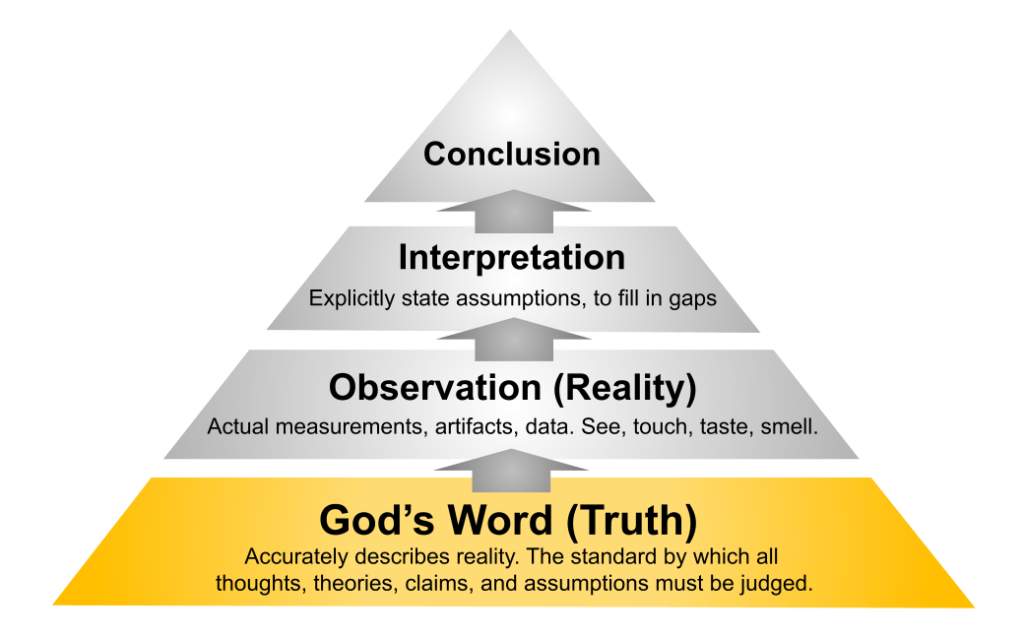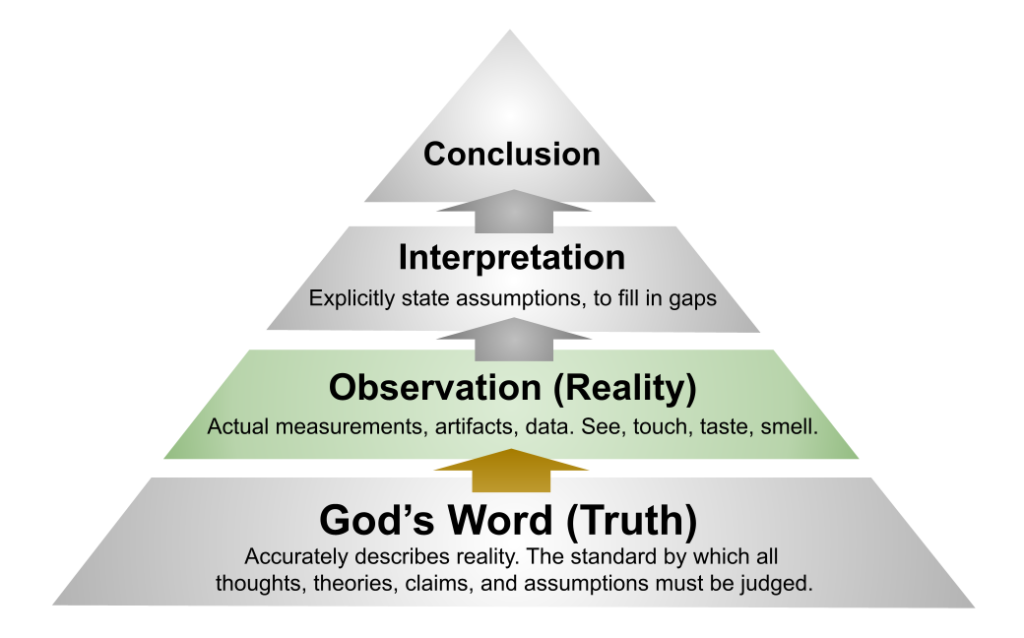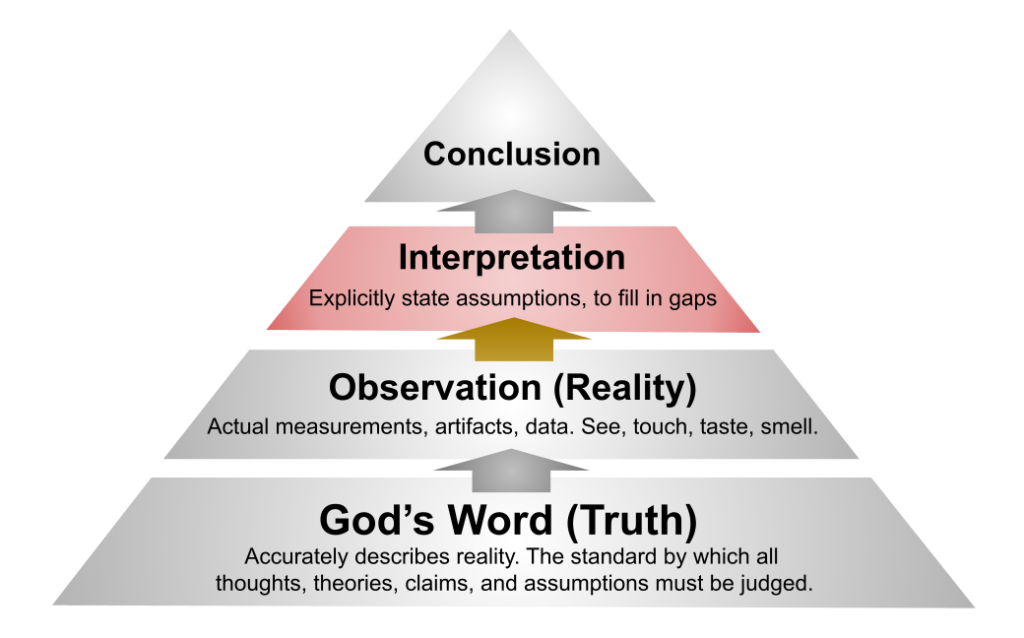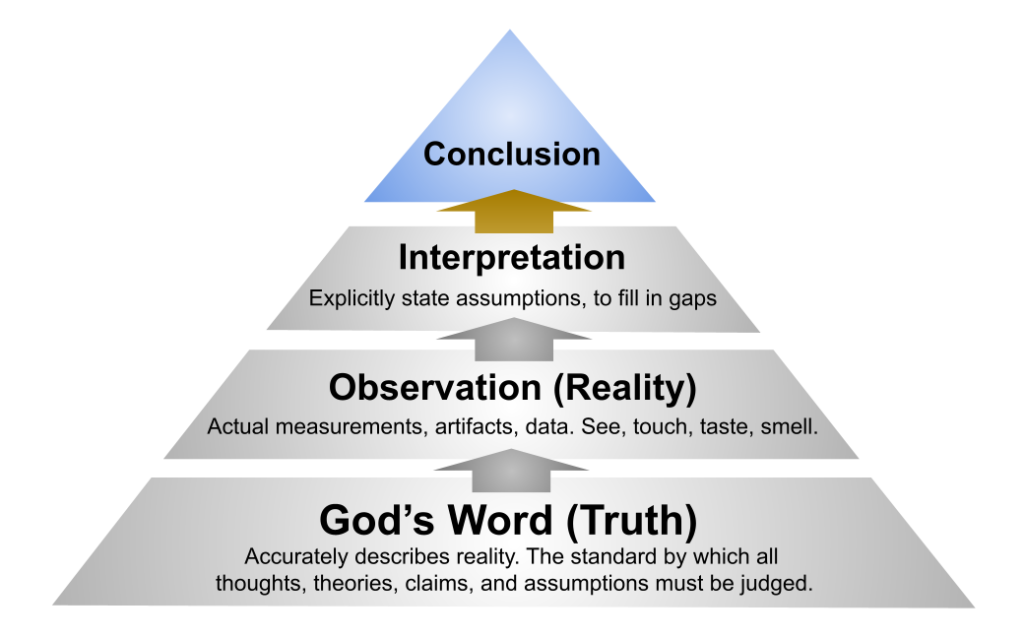Key Thoughts / Rapid Read
- WARNING! Avoid foolish controversies and irreverent babble. Before we enter these two strongholds [Science and History] of the Father of Lies we had best be certain that we heed the rules of engagement.
- Our aim is to demonstrate how Christians can engage in scientific and archaeological inquiry without contradicting the Bible. Our primary objective is not to show that Science or History prove the Bible, but to demonstrate that God will be glorified through an honest and accurate understanding of Science and History.
- Step 1 – Stand Firmly on the Solid Rock of God’s Word! God’s Word accurately describes reality. The Bible is therefore the standard by which all thoughts, theories, claims, and assumptions must be judged. We must correctly study and carefully interpret scripture so that we may “rightly handle the word of truth.”
- Step 2 – Observation: Actual Measurements and Data. It is essential to clearly distinguish between observations, and assumptions. Only cold hard facts are allowed at this stage. Any *assumptions* mistakenly categorized as *Observations* will be like Trojan Horses, ultimately destroying our subsequent reasoning and conclusions from within.
- Step 3 – Interpretation: Explicitly State Assumptions. By clearly writing our assumptions we ensure that error does not inadvertently creep into our arguments and conclusions. Specifically each assumption is evaluated to confirm the following: NO heresy, NO logical fallacies, NO factual inconsistencies, and NO wild speculation
- Step 4 – Conclusion. We seek to build a story that matches actual history. We use the term “Conclusion” loosely because the very reason that we are exploring these topics is because they are controversial, unknown, mysterious, or intriguing. I do not have all the answers (in fact I don’t have many answers) but I do like to ask questions and solve puzzles and problems. Come with us on this journey!
The Warning!
Our journey into the enticing and thrilling realms of science and history begins with a word of caution. Before we enter these two strongholds of the Father of Lies we had best be certain that we heed the rules of engagement, as Paul wrote in 2 Timothy:
(2:15) Do your best to present yourself to God as one approved, a worker who has no need to be ashamed, rightly handling the word of truth. But avoid irreverent babble, for it will lead people into more and more ungodliness. … (23) Have nothing to do with foolish, ignorant controversies; you know that they breed quarrels. And the Lord’s servant must not be quarrelsome but kind to everyone, able to teach, patiently enduring evil, correcting his opponents with gentleness. God may perhaps grant them repentance leading to a knowledge of the truth, and they may come to their senses and escape from the snare of the devil, after being captured by him to do his will. … (4:3) For the time is coming when people will not endure sound teaching, but having itching ears they will accumulate for themselves teachers to suit their own passions, and will turn away from listening to the truth and wander off into myths. As for you, always be sober-minded, endure suffering, do the work of an evangelist, fulfill your ministry.
2 Timothy 2:15-16; 23-26; 4:3-5 (ESV, emphasis mine)1
How then can we think about and examine questions and mysteries of science and history without falling into irreverent babble? How can we test theories and discoveries and legends while rightly handling the word of truth? Is it even profitable for a Christian to think upon these subjects? As teachers we will be judged with greater strictness (James 3:1) and it is therefore essential that we handle God’s word responsibly so that we may not lead people astray into myths, and so that we fulfill our calling and ministry faithfully … so that “God may grant repentance leading to a knowledge of truth” through our work.
Our aim is to demonstrate how Christians can engage in scientific and archaeological inquiry without contradicting the Bible. Our primary objective is not to show that Science or History prove the Bible, but to demonstrate that God will be glorified through an honest and accurate understanding of Science and History. We will investigate various theories and observations which allegedly conflict with the histories or timelines of the Bible, and demonstrate how to think accurately and consistent with scripture (especially when the answers are unclear). Behind all of this we need always to represent the Lord with patience, kindness, gentleness and humility. And above all we must rightly handle the Word of Truth, not seeking merely to gain followers by discussing myths and controversy but rather to fulfill the ministry of evangelism … that is, to point people to Chris through the stories of history.
We present here a brief overview of our methodology, outlined as 4 steps to avoid foolish controversies and irreverent babble:
Step 1 – Stand Firmly on the Solid Rock of God’s Word

God’s word is Truth and we accept that here without argument as the underlying presupposition. Others before me have provided various evidences for the truth of scripture, the accuracy of transmission of scripture through the ages and translation from the original languages, the existence of God, morality, etc. For “Truth”, we accept the definition that I first heard from Greg Koukl at Stand To Reason:
Truth is when an idea, a belief, or a statement matches the way the world actually is (reality)
Greg Koukl & team, at STR.org2
If you are interested in a more extensive philosophical discussion on the subject of Truth, check out the STR.org article titled “What Is Truth” linked in the footnotes. But for our purposes right now, we presuppose that God’s Word (aka “Scripture” or “the Bible”) is Truth. Here is our foundational presupposition, restated more concisely:
“God’s word accurately describes reality“
Since God’s Word accurately describes reality, it is therefore the standard by which all thoughts, theories, claims, and assumptions must be judged. The Bible cannot be in conflict with reality (the way things really are), because the Bible accurately describes reality. Therefore as Christians we need not be afraid of discovering something that will nullify our faith while pursuing scientific or historical inquiry!
Scripture was written under the inspiration of the Holy Spirit (God), and God cannot lie. But just because God’s word is truth does not mean that we automatically understand the truth. Many biblical scholars through the ages and still today have differing opinions and interpretations of God’s word. We must correctly study and carefully interpret scripture so that we may “rightly handle the word of truth.” We will demonstrate our method for Bible study in detail in future posts as we dive in.
Step 2 – Observation: Actual Measurements and Data

Next we document our observations of the world — of reality. Because God’s word accurately describes reality, our observations of reality (if accurate) should align with what is written in scripture. Observations include actual measurements, artifacts, and essentially anything that can be observed with the senses. This raw data is gathered through scientific investigation and archaeological excavation. Observation includes written documents, both modern as well as ancient manuscripts, tablets, and carved text … with the caveat that written information as recorded by others is especially subject to interpretation. When reviewing written documents it is crucial to distinguish between the what the author is recording as fact, and what interpretation and assumptions they are bundling into their conclusions.
In our methodology we draw a specific distinction between observation and interpretation. Observations consist of verifiable and/or repeatable facts and data, artifacts that can be observed, experiments that can be replicated. Interpretation adds one or more assumptions to draw a conclusion. Here is an example to demonstrate the difference between observation and interpretation:
List 6 observations from the following image?

What do you observe? Three coins? One penny, one dime, and one quarter? 36 cents total? Think about it for a moment? What conclusions are you jumping to, based on automatic assumptions that are ingrained? Pause for a moment and think about what you really observe in each of the three images. What is the same between each? What is different? What prior knowledge do you add automatically? And what assumptions do you make automatically, to arrive at the conclusion that these are three US coins, totaling 36 cents ?
Observations
- All three objects are round
- All three have engravings
- Each as a different head
- Two have dates, one does not
- All say IN GOD WE TRUST and LIBERTY
- One says UNITED STATES OF AMERICA.
- There are three different sizes
- One silver object is much larger than the copper object, and the other is slightly smaller.
- The largest says QUARTER DOLLAR
Prior Knowledge
- The US uses coins for money
- You may recognize the identity of the three heads, or at least know that they represent US coins
- You identify LIBERTY and IN GOD WE TRUST as phrases from US money
- You recognize DOLLAR symbolizes american money
- You recognize QUARTER, as the name of a US coin
- You know that a penny is 1 cent, a dime is 10, and quarter 25
Assumptions
- That the photographed objects are metal, not plastic or paper play money.
- That the metal objects are solid coins, not a thin layer of foil (you’ve eaten chocolate coins as a kid, right?)
- You assume that these are genuine legal tender, and not counterfeit
From this exercise we realize that numerous details of prior knowledge and assumptions are automatically activated. How many seconds did it take you to identify the three objects as coins? Your recognition was likely instantaneous. This automatic activation is tremendously useful in everyday life! But when delving into historical and scientific mysteries and questions, it is essential to clearly distinguish between what is actually being observed, and what is being assumed (or what prior knowledge is being automatically applied). Clear identification of the observations is necessary before moving on to step 3, because any assumptions mistakenly categorized as “Observations” will be like Trojan Horses, ultimately destroying our subsequent reasoning and conclusions from within. There is definitely a place for connecting prior knowledge and making assumptions in our methodology, but they need to be intentionally isolated from the observations. Here are a few characteristics of an observation — not all will apply every time but these are some good guidelines:
8 Traits of an Observation
- Measurements – Quantity, weight, dimensions, depth, speed, etc. CAUTION! Make sure you understand the methods, and the inherent limits, precision, and accuracy.
- Location – Above, below, behind, inside, etc.
- Orientation – vertical, horizontal, sloped, backwards, upside down, etc.
- Visual – color, patterns, contrast, brightness, etc.
- Texture – roughness, smoothness, uniformity, etc.
- Written documents – e.g. tablet with Sanskrit inscriptions, the dead sea scrolls, engravings on ancient stone monuments
- Observations can be either quantitative [a counted number such as 2 or 10] or qualitative [descriptions such as “dozens”, “too many to count”, “too heavy to lift”]. But more specific is better!
- 3rd-party reports – e.g. archaeological dig report, data from a scientific study, or a news article (video documentaries and podcasts also fit this category). CAUTION! Although the report itself is an observation, beware of un-stated assumptions that are wrapped into other people’s conclusions! The contents/facts/data and methods from 3rd parties need to be carefully understood and interpreted!
The objective of Observation is to keep the observations objective. NO ASSUMPTIONS IN STEP 2! Only cold hard facts are allowed at this stage. Observations should be free from the influence of personal biases. Anyone at any time should be able to repeat and agree on substantially the same observations, regardless of prior knowledge or personal background or history.
“The Objective of Observation is to Keep the Observations Objective”
Observations should be specific to what is actually being observed, not generalizations — e.g. referring back to the coins above, we see that all three have an engraved image of head, but we CANNOT generalize this observation and say that all US coins have heads … only that every coin we examined had a head. Save the generalization for Step 3 – interpretation. Also as stated above, treat 3rd party reports carefully! We will explore Interpretation in the next step.
Step 3 – Interpretation: Explicitly State Assumptions

Interpretation is the process of assembling the observations, like the pieces of a puzzle, to create a story. Unfortunately in the world of Science and History it often feels like assembling a 1000 piece puzzle with no box top and half the pieces missing. Growing up we had our share of difficult puzzles come across our kitchen table. Where do you start with a complex puzzle? After dumping out the pieces, what do you identify first and group together? For me, I always start with the edges because that provides a boundary condition with an easily identifiable trait: the edges all have one straight/flat side. The boundary allows us to identify a smaller set (edge pieces) to start with instead of all 1000 pieces, and furthermore we know that the flat edges will all be oriented towards the outside of the puzzle. By starting with a clear boundary condition, we set the context within which the remaining pieces can be observed, patterns identified, and the remaining pieces fit together.
For our purposes, the Bible sets the boundary conditions within which all other facts and observations need to be judged and interpreted. Remember our foundational presupposition from Step 1? God’s word accurately describes reality. The Bible does not give us detailed information on all aspects of creation or history, but where it does provide specific details we trust that it is accurate. In brief the following sequence represents an initial Biblical framework of history (details are intentionally omitted for now):
You are trying to load a table of an unknown type. Probably you did not activate the addon which is required to use this table type.
The above table outlines an extremely abbreviated sequence of events, as a starting point for establishing the scriptural context. Through our ongoing study of the Bible we will fill in details for the above, as well as add additional events to our timeline as we delve deeper into history.
After establishing our scriptural context to the best of our ability, we then create our best interpretation of the observations. Our goal is the explore question, mysteries and wonders of science and history so we will often be working with incomplete to extremely limited information. In order to build a story we will need to make certain assumptions based on our prior knowledge and experience. Assumptions allow us to fill in missing details and make connections, ultimately crafting a story that (to the best of our knowledge and ability) hopefully matches reality. In order to remain transparent, all assumptions need to be explicitly stated — that is, written out clearly. We specifically emphasize writing out assumptions because that ensures that we don’t inadvertently wrap assumptions into the conclusion. Assumptions are necessary to fill in missing information, but we need to clearly distinguish between what we have observed vs. what we have added in our interpretation.
“Explicitly state assumptions — that is, write them out clearly”
By clearly writing our assumptions we ensure that error does not inadvertently creep into our arguments and conclusions. Specifically each assumption is evaluated to confirm the following:
- NO heresy => reject any assumption that contradicts scripture
- NO logical fallacies => reject any assumption that violates logic
- NO factual inconsistencies => reject any assumption that is refuted by facts or observations
- NO wild speculation => reject any assumption that is extremely complex or convoluted
Our assumptions must always be consistent with logic, consistent with observed facts and data, and above all consistent with the truth as revealed in scripture. We also favor the simplest explanations and reject wild speculation. Clearly stating our assumptions also allows other people to understand the difference between facts and what we are adding. It also provides clear opportunities for other people to challenge our conclusions while agreeing on the underlying observations of fact.
The goal of our interpretation is to craft a story that matches reality as closely as possible, which brings us to Step 4 – Conclusion
Step 4 – Conclusion

Ultimately each investigation into science and history will culminate in a conclusion. Our conclusions rest on solid interpretation. Our interpretation rests on solid facts, supplemented by well-reasoned assumptions. And everything is grounded on the solid foundation of the word of God. We use the term “Conclusion” loosely because the very reason that we are exploring these topics is because they are controversial, unknown, mysterious, or intriguing. That being said, our information may at times be limited such that our “conclusions” may land somewhere on the “Fruitful Speculation” end of the scale.

Sometimes we may not be able to do more than establish an initial boundary within which to direct our next efforts and questions. We eliminate options which contradict scripture, violate logic, are refuted by facts, or involve wile speculation. Sometimes when dealing with especially limited information and/or apparently conflicting knowledge it may be helpful to identify multiple alternative hypotheses (aka educated guesses). Our conclusions are also a work-in-progress. New information is constantly discovered, and information that has already been discovered is brought to our attention. We seek the truth (i.e. we seek to build a story that matches actual history). Therefore do not shy away from evidence, even if it goes against our previous theories and best guesses!
I do not have all the answers (in fact I don’t have many answers) but I do like to ask questions and solve puzzles and problems! Come with us on this journey. Humility will be our guiding principal: humility to admit what we don’t know, and humility to trust in the truth of God’s word.
- Unless otherwise indicated, and/or where marked (ESV), all Scripture quotations are from The ESV® Bible (The Holy Bible, English Standard Version®), © 2001 by Crossway, a publishing ministry of Good News Publishers. Used by permission. All rights reserved.” ↩︎
- Brake, Aaron. “What Is Truth?” STR.org, Stand to Reason, 6 Feb. 2018, www.str.org/w/what-is-truth-1. Accessed 21 Feb. 2024. ↩︎
